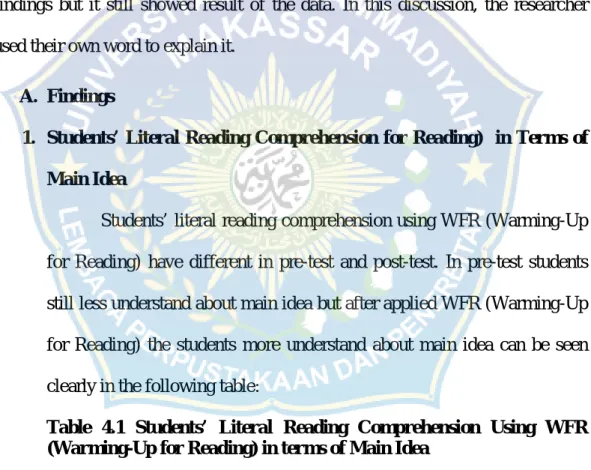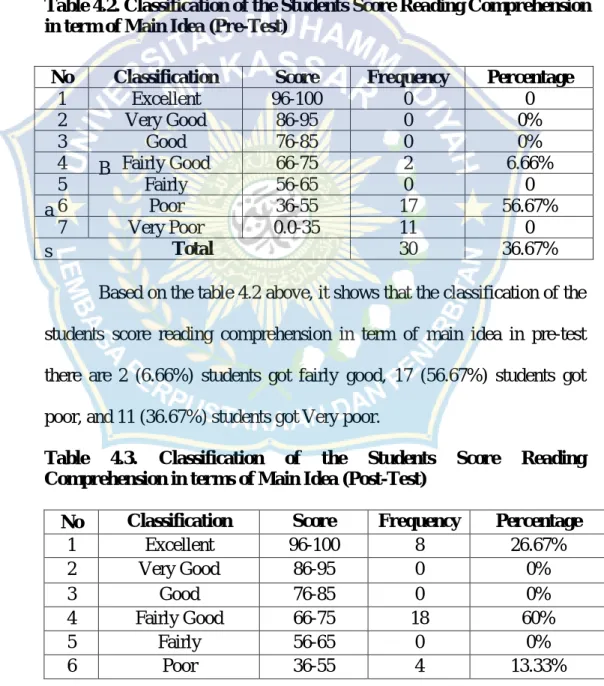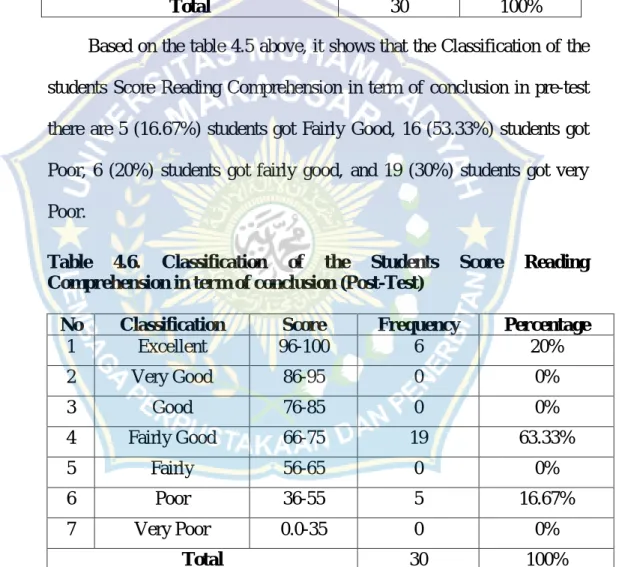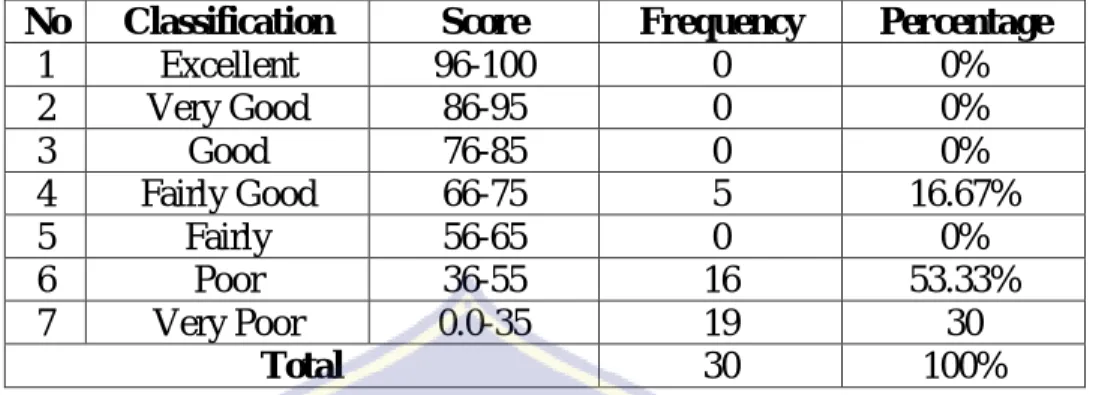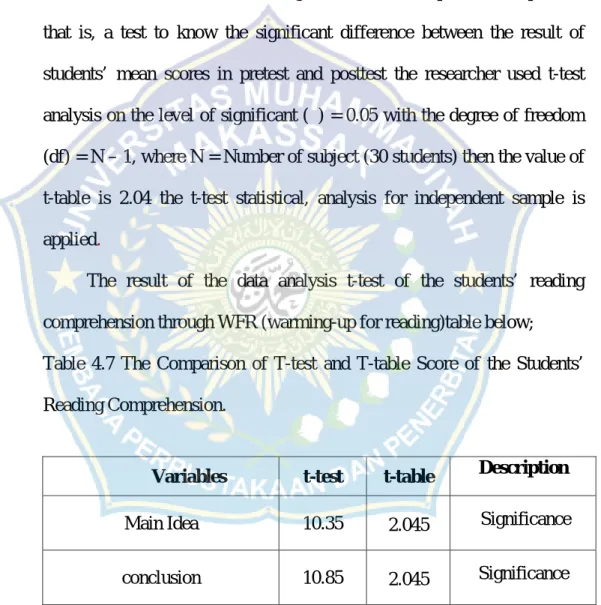The researcher used a pre-experimental research by applying with one group of pretest and posttest. The researcher expresses his high gratitude to Allah SWT because of the blessing and mercy upon him so that the researcher could complete this thesis titled "Teaching Reading by Using WFR (Warming-up for Reading) to Increase Reading Skills at Students of MA DDI Attaufiq Padaelo' '(Pre-Experimental Research).FKIP Unismuh Makassar, and also all lecturers who have taught the researcher during the study at Makassar Muhammadiyah University.
Based on the above statement, the researcher is inspired to conduct a research titled "Teaching Reading Using WFR (Warm Up for Reading) to Increase Reading Skills in MA DDI Attaufiq Padaelo Students".
Problem Statement
Objective of the Research
Knowing the use of WFR (Warming-Up for Reading) increases students' literal reading comprehension at MA DDI Attaufiq Padaelo. Knowing the use of WFR (Warming-Up for Reading) increases students' interpretive reading comprehension at MA DDI Attaufiq Padaelo.
Significance of Study
Scope of the research
Previous Related Findings
Concept of Reading 1. Definition of Reading
- Types of Reading
- Reason for Reading
- Definition of Reading Comprehension
- Level of Comprehension
- Factors Affecting Reading Comprehension
- Goals of Pre-Reading Activities
- The Implementation of Warming-Up for Reading
Reading comprehension is the process of understanding the writer's message by combining the meaning of the text and the pictures in the reader's mind. Reading aloud activity introduces learners to some of the vocabulary and the topics in the text and may motivate them to want to read further. Based on the title, and before reading, students are asked to write the prediction of the words that will appear in the text.
After checking the vocabulary, the student writes known and unknown words in the text.
Narrative Text
- Definition of Narrative Text
- The Generic Structure of Narrative Text
- The Purpose of Narrative
- Example of Narrative Text
Narrative is not the story itself, but rather the telling of a story, which is why it is so often used in phrases such as written narrative, oral narrative, etc. Junior High School. The characters, setting, and problem of the narrative are usually introduced at the beginning.
Evaluation: Stepping back to evaluate the story or the moral massage of the story.
Conceptual Framework
Output refers to students' reading skills after being taught using the Warming-Up for Reading (WFR) method.
Hypothesis
Design of the Research
The post-test aims to recognize significant differences between student achievement before and after the application of warm-up for reading (WFR).
Research Variables and Indicators 1. Variables
Population and Sample 1. Population
Instruments of the Research
In this part, students were given a test on a narrative text, where they have to answer questions. As the discussion progresses, the researcher uses the warm-up method for reading. The test is the same as the test in the pre-test and post-test for the students to know if there is any improvement of the students.
Techniques of Data Analysis
To know the significance of the differences between the pre-test and post-test score, the researcher calculated the test value using the following Formula. This chapter answered the problem statement in the previous chapter and consisted of findings and discussion. The findings showed the description of the result from the data that was collected through the pre-test and post-test reading test.
Findings
Students’ Literal Reading Comprehension for Reading) in Terms of Main Idea
Based on Table 4.1 above, it shows that there are differences in students' pretest and posttest scores of main idea in narrative text. The data analysis shows that students' average scores improve from pretest to posttest. This means that the use of WFR (Warming-Up for Reading) was effective in improving students' literal reading comprehension in the term's main idea of narrative text.
The graph 4.1 above shows the difference between the average score of students on the generic structure in pre-test and post-test. The students' mean score for literal reading comprehension in terms of the main idea in the pre-test was 42.5. Thus, using WFR (Warming-Up for Reading) is effective in improving students' literal reading in terms of the main idea in narrative text.
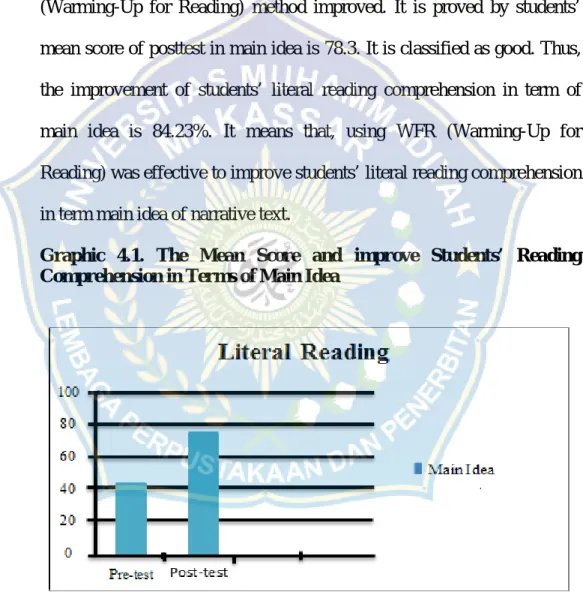
Students’ Interpretative Reading Comprehension Using WFR (Warming-Up for Reading) in Terms of Conclusion
Students' interpretive reading comprehension using WFR (Warming-Up for Reading) in terms of completion. Improved warm-up method for reading). This means that the use of WFR (Warming-Up for Reading) was effective for improving students' interpretive reading comprehension in the completion of the narrative text term. The mean score of students' interpretive reading comprehension in terms of completion in the pretest was 46.6 and the mean score of students' interpretive reading comprehension in terms of completion in the posttest was 75.83, and the improvement between pretest and posttest was 62.51%.
Table 4.6 above, i shows that the classification of the students scores reading comprehension in terms of conclusion in the post-test.
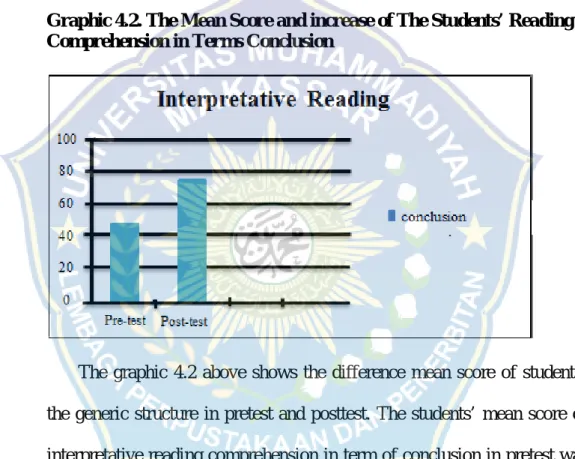
Hyphothesis Testing
The result in the reading comprehension variable is (10.85> 2.045). It is said that the null hypothesis (Ho) is rejected and the alternative hypothesis (H1) is accepted. If the t-test value is higher than the t-table at a significance level of 0.05 and a degree of freedom (df) of 30 (N-1=30-1), the alternative hypothesis (H1) is accepted and the null hypothesis (HO) is rejected. Otherwise, if the value is lower than the t-table at a significance level of 0.05 and a degree of freedom of 29, then this alternative hypothesis is rejected and the null hypothesis is accepted.
Discussion
Students’ Literal Reading Comprehension Using WFR (Warming-Up for Reading) in Terms of Main Idea
Students' literal reading comprehension is supported by students' mean scores on the pre- and post-test on the main idea of 46.6 and 75.83. Before applying WFR (reading warm-up), the students could not decide on a clearly identified main idea by presenting strong arguments. evidence, details related to the main idea. But after applied WFR (reading warm-up), the students can easily determine the main idea. After calculating the score of the students on the Literal Reading Comprehension indicator in the pre- and post-test, also explain the classification of the students' improvement in literal reading comprehension.
After the treatment, the score classification of the students in the post-test is changed: 8 (26.67%) students scored excellent, 18 (60%) students scored fairly good, 3 (10%) and students got bad. Based on the above finding when applying WFR (reading warm-up) in the classroom, the data is collected through the test as explained in the previous findings section. This shows that the students' understanding of the literal language has improved significantly. The student's post-test score is higher than the student's pre-test average score. Therefore, it can be concluded that WFR (reading warm-up) could improve the students' comprehension in literal reading comprehension.
Students’ Interpretative Reading Comprehension Using WFR (Warming-Up for Reading) in terms of Conclusion
After calculating the student's score of the literal reading comprehension indicator in the pre-test and after the exam, also explain the classification of the student's development of interpretive reading comprehension. Based on the above finding when using WFR (reading warm-up) that is effective in the classroom, the data collected through the test as explained in the previous findings section shows that the students. The student's posttest main score is higher than the student's pretest mean score.
Therefore, it can be concluded that WFR (Warm Up for Reading) were effective could improve students.
The Significant Difference of T-test and T-table
This means that the use of WFR (Warming-Up for Reading) was effective in teaching reading comprehension and could improve students' reading comprehension. WFR (Warming-Up for Reading) has been found to effectively improve students' comprehension in literal and interpretive reading. In the pre-test, it was difficult for some students to answer the questions and identify the main idea and conclusion.
But the students' reading comprehension in the post-test as the content of reading comprehension could be understood. And then the students found it easy to answer the questions and find out the main idea and conclusion. From the discussion above, it could be concluded that eleventh grade students of MA DDI Attaufiq Padaelo have good skills in reading after being taught through WFR (Warming-Up for Reading), especially in understanding a text.
This chapter contains conclusion and proposal based on the research findings in the previous chapter, the author makes the following conclusion and proposal:.
Conclusion
Suggestion
Literal Reading Comprehension in Term of Main Idea
Interpretative Reading Comprehension in Term of Conclusion
Scoring Classification of The Students Pretest and Posttest Conclusion
D = The sum of the total difference score. D2 = The square of the sum of the difference score. He summoned one of his herd's elephants, who were not trapped, to seek help from the king and told him about the captive elephants. Go on, leave before I change my mind.' The little mouse ran away as fast as his paws could.
Ø Evaluation: A step back to evaluate the story or the moral massage of the story. The purpose of the text is to amuse or amuse readers or listeners about the story. Deer, chipmunk, raccoon, wolf, bear and many other creatures climbed to the top of the highest mountain.
The biggest and most powerful animal in the forest was the bear, and he was the first to reach the mountain top. He said that the creatures of the forest would sleep better in darkness because there would be no light to keep them awake. Raccoon said that he didn't mind the darkness because he was so smart that he could find a lot of food even in the dark.
Squirrels, the smallest animal, argued that it would be better to have both light and dark. The bear got tired of talking, and the squirrel chatted on and on as if she had all the energy in the world.
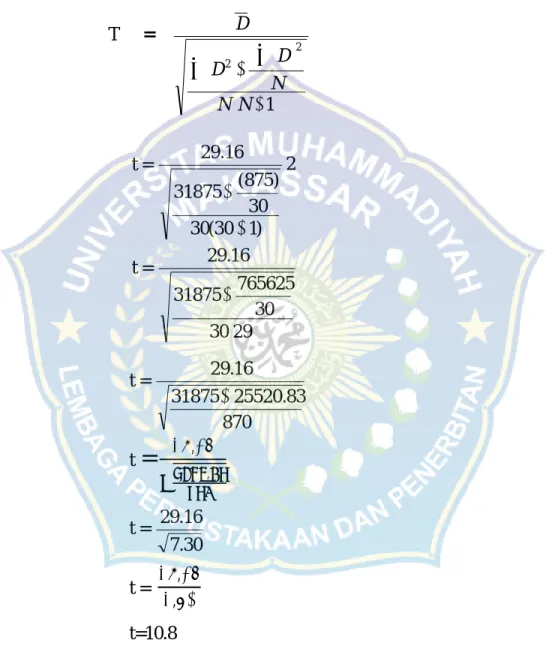
STANDAR KOMPETENSI
KOMPETENSI DASAR
INDIKATOR
Pemahaman yang akurat, lancar dan berterima terhadap teks monolog/esai berbentuk narasi dalam konteks kehidupan sehari-hari dan akses terhadap ilmu pengetahuan. Siswa dapat memberikan kesimpulan tentang isi teks E. Metode/teknik pembelajaran: pemanasan membaca G. 1) Guru menyampaikan materi yang akan disampaikan 2) Guru memberi judul teks kepada siswa. Siswa dapat memberikan kesimpulan tentang isi teks E. Metode/teknik pembelajaran: pemanasan membaca G. 1) Guru menyampaikan materi yang akan disampaikan 2) Guru memberi judul teks kepada siswa.
